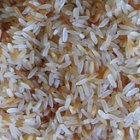Scientists find genetic trick to make iron-rich rice
26 September 2011 | EN |

Field trials of the GM rice have already begun
Flickr/loopcd
[MANILA] Scientists say they have made a breakthrough in their quest to develop a rice variety to address iron and zinc deficiencies that affect millions of people in poor countries across Asia.
The genetically modified (GM) rice has up to four times more iron than conventional rice and twice as much zinc, Alex Johnson, from the Australian Centre for Plant Functional Genomics (ACPFG) told SciDev.Net.
"The rice has some of the highest iron concentrations that have been described for white rice (up to 19 parts per million). We have also demonstrated that the iron is in the endosperm tissue that makes up white rice," Johnson said. This is important because of the widespread consumption of white rice.
"This new report documents the early and exciting results for one approach for increasing the iron content of the rice grain," said Gerard Barry, leader of the Rice Crop Team of the US-based HarvestPlus, which partially funded the research. "The increase in iron in the polished grain is very important in terms of human nutrition."
HarvestPlus, which promotes biofortification research, usually focuses on conventional plant-breeding methods. But increasing the level of iron in rice is hard to achieve through conventional breeding because there are few naturally occurring varieties of rice with higher concentrations of iron to kick off the breeding process.
Johnson and his team focused on nicotianamine, a substance that occurs naturally in rice and helps it to take up iron from the soil. Normally, it is low levels of iron in the soil that signal to the rice to switch on the genes that control the production of nicotianamine. The scientists have succeeded in keeping these genes switched on all the time.
The method also boosted zinc levels.
Johnson said that, since nicotianamine naturally occurs in rice, consumption was unlikely to have any adverse health effects.
But he said it would take ten years before the new rice variety could be released for human consumption, because of the need for evaluation in the field over several seasons, and the need for bioavailability studies to discover whether animals actually absorb the iron.
Field trials have begun at the Philippines-based International Rice Research Institute (IRRI).
=================================================
No comments:
Post a Comment